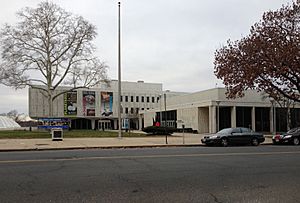New Jersey State Museum facts for kids
 |
|
| Lua error in Module:Location_map at line 420: attempt to index field 'wikibase' (a nil value). | |
| Established | 1895 |
|---|---|
| Location | Trenton, New Jersey |
| Type | State museum of New Jersey |
| Collection size | 2+ million objects |
The New Jersey State Museum is a super cool place to explore! It's located in Trenton, New Jersey, the capital city of New Jersey. This museum is packed with amazing collections. You can see everything from ancient fossils and rocks to old tools and art.
The museum also offers fun activities, learning programs, and special talks. It even has a planetarium where you can explore space and a big auditorium for events. The New Jersey State Museum is officially recognized by the American Alliance of Museums, showing it's a top-notch place!
Contents
Discover the Museum's History
The New Jersey State Museum has a long and interesting past. It was the very first state museum in the United States created specifically to teach people. It's also one of the oldest state museums around! The state government officially started the museum in 1895. At first, it was located in the New Jersey State House.
How the Collections Grew
When it first opened, the museum mostly focused on natural history. This meant it had lots of rocks, minerals, and fossils. These came from surveys of New Jersey's geology, which started way back in 1836.
In 1912, the museum began collecting archaeological items. These were artifacts made by Native Americans who lived in the region. Some were from prehistoric times, and others were from when Europeans first arrived.
By 1922, the museum was one of the first on the East Coast to show Native American objects as art. This is how its ethnographic collections began. These collections show the cultures and ways of life of different groups. In 1924, the museum added decorative arts, like beautiful pottery from Trenton.
A New Home for the Museum
The museum moved to a bigger space in the State House Annex in 1929. In the mid-1900s, it started focusing more on fine art. It began collecting many paintings, sculptures, and drawings.
Then, in 1964, the museum moved into its very own special buildings. These were built just for the museum as part of the Capitol Cultural Complex. The main museum building has four floors of exhibits, labs, and a gift shop. It also has the awesome planetarium! A nearby building holds an auditorium and more gallery spaces.
Explore the Museum's Collections
The New Jersey State Museum organizes its vast collections into different areas, called bureaus. Each bureau focuses on a specific type of history or art.
Bureau of Archaeology and Ethnography
This bureau is like a treasure chest of ancient objects! It holds about 2.4 million prehistoric and historic items. These were found during excavations over 100 years. It also has nearly 4,000 ethnographic objects.
The ethnographic collection includes items from the Lenape people and other Native American groups from North America. These objects help us understand their cultures and traditions.
Bureau of Cultural History
The Bureau of Cultural History has over 13,000 artifacts. These items tell the story of New Jersey's culture, economy, military, politics, and social history. You can also see examples of decorative arts.
This bureau also takes care of important military flags. These flags were used by New Jersey regiments during the Civil War and World War I. They are kept safe in the New Jersey State Capitol.
Bureau of Fine Art
The State Museum has an amazing collection of over 12,000 works of art. This includes paintings, prints, drawings, sculptures, and photographs.
The art collection mainly focuses on American art. It highlights the work of artists from New Jersey. You can also see art that shows New Jersey scenes and events. The collection is especially strong in modern American art and works by African-American artists. It also has many works by famous artists like Ben Shahn and Jacob Landau.
Bureau of Natural History
This bureau is all about the natural world! It has about 250,000 specimens. These include industrial minerals, ores, and paleontological specimens (which are fossils!). You can also see osteological specimens (bones) and modern shells.
The collection also has pinned insects, preserved fauna, and taxidermy mounts. There are even about 300 types of Paleozoic and Mesozoic fossils. You can see minerals from the famous zinc mines of Franklin-Sterling Hill. This includes the largest number of fluorescent mineral species in the world!
Learning and Fun Programs
The museum's Bureau of Education offers many programs and events. School groups can take classes, workshops, and tours of the exhibits. They can also enjoy the exciting planetarium programs.
The Planetarium Experience
Since it opened in 1964, the State Museum's planetarium has been a huge hit! It uses "Full Dome" video technology to create amazing experiences. You can see displays of constellations, models of the Solar System, and go on virtual space exploration journeys. The planetarium has public shows on weekends, during school breaks, and in the summer. It's a fantastic way to learn about the universe!
See also
- New Jersey State Library

